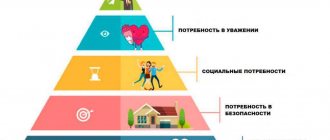Theory of temperament according to Hippocrates and Galen
Four temperaments in the form of visual emoticons (names from left to right and top to bottom: phlegmatic, choleric, sanguine, melancholic)
The magic of numbers in the Mediterranean civilization led to the doctrine of the four temperaments, while in the East a five-component “world system” developed.
The word “temperament” (from Latin peramentum) translated from Latin means “stable mixture, ratio of parts”; the Greek word “krasis” (ancient Greek κράσις, “fusion, mixing”), which is equal in meaning to it, was introduced by the doctors of antiquity Hippocrates and Galen. They suggested that there are stable individual differences in the relationships between chemical systems that regulate human behavior. Despite the fact that Hippocrates was among the first to point out the role of the brain in the general regulation of behavior, he attributed the most stable individual differences to differences in mixtures of neuro-humoral body fluids. Hippocrates suggested, and Galen explained temperament in more detail as behavioral characteristics, the predominance in the body of one of the “vital juices” (four elements):
- The predominance of lymph (ancient Greek φλέγμα, phlegm
, “phlegm”) makes a person calm and slow -
phlegmatic
. - The predominance of yellow bile (ancient Greek χολή, chole
, “bile, poison”) makes a person hysterical and boorish, “hot” -
choleric
. - The predominance of blood (Latin sanguis, sanguis
,
sangua
, “blood”) makes a person active and cheerful -
a sanguine person
. - The predominance of black bile (ancient Greek μέλαινα χολή, melena chole
, “black bile”) makes a person sad and fearful -
melancholic
.
Temperaments: a sketch of statues of the 17th century, part of the Grande Commande, by Charles Lebrun
People with pronounced traits of a certain temperament are not very common; most often people have mixed temperament in various combinations. But the predominance of traits of any type of temperament makes it possible to classify a person’s temperament as one or another type. One of the most common classifications of temperament types in Russian literature:
Choleric
- fast, impetuous, but completely unbalanced, with sharply changing moods with emotional outbursts, quickly exhausted. He does not have a balance of nervous processes, this sharply distinguishes him from a sanguine person. A choleric person has a tremendous capacity for work, however, when he gets carried away, he carelessly wastes his strength and quickly becomes exhausted.
Phlegmatic person
- unhurried, unperturbed, has stable aspirations and mood, outwardly stingy in the manifestation of emotions and feelings. He shows perseverance and perseverance in his work, remaining calm and balanced. He is productive at work, compensating for his slowness with diligence.
Sanguine
- a lively, hot-tempered, active person, with frequent changes of impressions, with a quick reaction to all the events happening around him, quite easily coming to terms with his failures and troubles. Usually a sanguine person has expressive facial expressions. He is very productive at work when he is interested. If the work is uninteresting, he treats it indifferently and becomes bored.
Melancholic
- prone to constantly experiencing various events, he reacts sharply to external factors. He often cannot restrain his asthenic experiences by force of will; he is highly impressionable and emotionally vulnerable.
This concept still influences literature, art and science. Types of temperament played an important role in the psychology of modern times, in the philosophy of Immanuel Kant and Rudolf Hermann Lotze. The reason for the persistence of the Hippocratic-Galen theory may be that they were the first to describe four types of behavior that are truly associated with imbalances in neurotransmitter (neurochemical) systems, which, when imbalanced in extremes, manifest as psychiatric profiles. These profiles have been recognized by humanity for more than 2,500 years and are reflected in the international classifications of psychiatric diseases (DSM or ICD). Below is a list of borderline states that are observed with pronounced temperament.
| Types according to Hippocrates-Galen | Temperament Traits | ICD-10 diagnoses | ICD-10 codes † |
| Choleric | Impulsivity, aggression | Impulsive personality disorder | F60.30 |
| Phlegmatic person | Socially withdrawn, self-absorbed | Schizoid personality disorder | F60.1 |
| Melancholic | Sad, fearful, depressed, weak | Anxious personality disorder | F60.6 |
| Sanguine | Active, social, self-confident | Hypomania | F30.0 |
Introduction
As you know, no two people have exactly the same fingerprints; no tree has two identical leaves. In the same way, no two people are the same; every person is unique.
However, a person is not born with an already formed personality. He gradually becomes a person. But even before a person becomes a person, he has individual mental characteristics. These specific mental characteristics are quite conservative and stable. They form in each person a kind of psychic soil, on which subsequently, in accordance with their expression, personality traits that are inherent only to a particular person grow. This means that the child’s psyche is not like a smooth board on which any patterns can be written, and in the process of raising and teaching a child it is necessary to rely on his qualities existing from birth. These characteristics are different for everyone. When we observe the behavior of students, how they work, study and relax, how they react to external influences, how they experience joys and sorrows, we, of course, pay attention to large individual differences between people. Some of them are fast, impetuous, impetuous - while others are slow, calm, imperturbable. It should be noted that these differences do not relate to the content of personality, but to some external manifestations. This page characterizes the concept of “temperament”.
The famous psychologist Merlin wrote: “Imagine two rivers - one calm, flat, the other fast, mountainous. The flow of the first is barely perceptible, it smoothly carries its water, there are no bright splashes, stormy waterfalls or splashes. The flow of the second is the complete opposite. The river rushes quickly, the water in it seethes, boils and turns into flakes of foam when it hits the stones...” Something similar can be observed in human behavior.
Observations have shown that all people are different not only in appearance, but also in behavior and movements. For example, if you monitor the behavior of students in the classroom, you can immediately notice the difference in the behavior and movements of each student. Some are leisurely, correct movements, noticeable calm in the eyes, while others are sudden movements, bustle in the eyes. What explains the difference in behavior? Firstly, temperament, which manifests itself in any activity (play, work, study, creative), in gait, gestures, in all behavior. The individual psychological characteristics of a person and his temperament give a unique color to all activities and behavior.
Temperament should be understood as natural behavioral characteristics characteristic of a particular person, manifested in the dynamics, tone and balance of reactions to the influences of life. Temperament colors all mental manifestations of an individual; it influences the nature of the flow of emotions and thinking, volitional influence, the pace and rhythm of speech. But we must remember that temperament does not depend on the interests or hobbies or social position and moral education of a person. The above examples lead to the understanding that temperament is a category of behavior that is a set of formal, dynamic characteristics of behavior. In this case, this primarily relates to the energy level of behavior. Scientists identify a large number of different characteristics of temperament, including impulsivity, anxiety, plasticity, emotional excitability, strength of emotions, reactivity and much more. However, the two main characteristics of temperament are general activity and emotionality.
Hippocrates' teaching on types of temperament
Hippocrates (an ancient Greek physician) understood temperament as the anatomical, physiological and individual psychological characteristics of an individual. Hippocrates, and later Galen, spoke of temperament as the behavioral characteristics of an individual in whose body one of the four “vital juices” is predominant.
- In choleric people, yellow bile (“bile, poison”) predominates, which makes him impulsive and uncontrollable.
- In phlegmatic people, lymph (“phlegm”) predominates, which makes a person calm, calm, and slow.
- In sanguine people, blood (“blood”) predominates, which makes him cheerful and active.
- In melancholic people, black bile (“black bile”) predominates, which makes him timid, fearful, and sad.
Bibliography
- S.L. Rubinstein // Fundamentals of general psychology // St. Petersburg: Petersburg Publishing House, 2000.
- Kretschmer E. Theory of temperaments // Psychology of individual differences. Textbook. M., 2000.
- Kant. About temperament//Psychology of individual differences. Texts. M., 1982.
- W. Sheldon. Psychology of individual differences. Texts / Edited by Yu.B. Gippenreiter, V.Ya. Romanov. M., 1982.
- V.S. Merlin, Outline of a Theory of Temperament, 1973.
- Klimov E.A. Individual style of activity // Psychology of individual differences: texts. - M., 1982.
- Pastelov I.G. Temperament through the eyes of an ordinary person // Life and Health. - M., 2001.
- Ilyin E.P. Psychology of individual differences. - St. Petersburg, Peter, 2004.
additional literature
- Great Soviet Encyclopedia: In 30 volumes - M.: “Soviet Encyclopedia”, -.
- Chess., S. (1997). Temperament: Theory and Clinical Practice. Harvard Mental Health Letter, 14(5), 5-7.
- Davidson, D. A. (2005). Psychosocial Issues Affecting Social Participation. In J. Case-Smith (Ed.), Occupational Therapy for Children (pp. 449–480). St. Louis: Elsevier Mosby.
- Maziade, M. (1983). Le tempérament de l'enfant, les différences individuelles et les forces environnementales. Santé mentale au Québec, 8(2), 61-67.
- Olson, L. J. (1999). Psychosocial Frame of Reference. In P. Kramer & J. Hinojosa (Eds.), Frames of Reference for Pediatric Occupational Therapy (pp. 323–375). Philadelphia: Lippincott Williams & Wilkins.
- Zeanah, C. H., & Fox, N. A. (2004). Temperament and Attachment Disorders. Journal of Clinical Child & Adolescent Psychology, 33(1), 32-41.
Types of temperament
Today the most common typology is one that includes 4 temperaments.
An individual with a sanguine type of temperament is distinguished by the relatively weak intensity of mental processes and the rapidity of replacement of some processes by others. A sanguine person is characterized by the ease and speed of the emergence of new states of an emotional nature, which, due to the rapid change from one state to another, do not leave a deep mark in his consciousness.
Often a sanguine individual is distinguished by rather rich facial expressions, and his emotional disturbances are accompanied by a variety of expressive gestures and movements. In principle, a sanguine person can be called a cheerful person, distinguished by high mobility. External mobility is associated with the speed of mental processes. Therefore, he is quite impressionable, less concentrated, quickly responds to external stimuli and is focused on his own personal experiences.
Sanguine people cope quite easily with assigned tasks, requiring quick thinking, provided that such tasks are not overly difficult or serious. A sanguine subject easily takes on various activities, but at the same time also easily forgets about them due to the appearance of interest in a new activity. He is often hasty in making decisions and rarely thinks about them for a long time. It is characterized by ease of communication interaction with the surrounding society. At the same time, his attitude towards people can be described as superficial, since he easily and simply parts with all attachments, very quickly forgets troubles and joys, disappointments and grievances.
The choleric individual is characterized by great strength and vivid manifestation of emotional reactions and the speed of their occurrence, which is demonstrated in the ardor and quickness that immediately follows violent experiences. Choleric is characterized by hot temper, passion and is characterized by a sharp change in emotional states and feelings. For a choleric person, all feelings are very deep, which determines that they can capture him entirely. He always deeply and strongly experiences all the sorrows and joys, which is manifested in his facial expressions, gestures and actions. Individuals of the choleric type are distinguished by high mobility, but the nature of their mobility is slightly different than that of sanguine people. A sanguine person is characterized by speed, smoothness and dexterity in movements, and a choleric person is characterized by sharpness and swiftness. The choleric type is characterized by high activity and energy.
A melancholic individual tends to have rather slow processes. The emotional experiences of people with this type are distinguished by significant depth, which leaves an imprint on the entire structure of his personality. The emotions, moods and feelings of a melancholic person are characterized by monotony, but at the same time stability. Often they are asthenic in nature. Melancholic individuals often react quite painfully to external circumstances, are quite easily wounded, and have a hard time experiencing life’s difficulties. Often among them you can find closed and uncommunicative people. The appearance of a melancholic person is characterized by slow movements, monotony and restraint. The psychological characteristics of the temperament of a melancholic person are expressed in decadence, lack of vigor and firmness in one’s actions, constant doubts, and in more extreme manifestations, passivity, lethargy, and disinterest in the work entrusted to the individual.
Outwardly, a phlegmatic subject is distinguished mainly by low mobility, slowness and lethargy of movements, and lack of energy. One should not expect quick reactions and actions from such a person. It is characterized by low emotional excitability. The feelings and moods of a phlegmatic person are characterized by evenness and slow variability. Such a person is characterized by equanimity and measured actions. The facial expressions and gestures of a phlegmatic person are rather monotonous and pale, speech is leisurely, devoid of liveliness, and is not accompanied by expressive movements. Before any activity, a phlegmatic person will think long and thoroughly about future actions. However, along with this, the phlegmatic person will carry out the decisions made calmly and follow them relentlessly. It is characterized by attachment to familiar work and poor ability to switch to new activities.
However, you should not think that personality can be attributed to only one of the types of temperament presented above. Pure sanguine or phlegmatic people, choleric or melancholic people practically do not occur in real life. The character of any individual usually unusually combines traits characteristic of different temperaments. Also, there are no types of higher nervous activity that would be ideally suited for performing this or that activity, since any type of activity makes certain demands on the individual’s psyche and its dynamic properties. Therefore, we can conclude that temperament and activity are closely interrelated. Activities can contribute to the development of certain temperament qualities.
Modern theories of temperament
The modern interpretation of the doctrine of temperaments differs only in the statement that every person has all types of temperament, but with a predominance of one of them. However, scientists are more inclined to consider the dependence of human behavior on the type of figure than on the interaction of internal fluids.
A group of Western European scientists at the turn of the 19th and 20th centuries put forward a theory of the relationship between temperament and the constitutional features of the structure of an individual’s body. For example, the German psychiatrist Kretschmer put forward the idea that mental illness is associated with the constitutional features of the structure of the body:
- Asthenics - fragile, angular physique; the author of the theory proposes to call them leptosomatics.
- Pickwick is a man of large build, sometimes with a barrel-shaped figure. Distinguished by stooping.
- Athletic is a muscular type without a pronounced layer of fat. Features a wide shoulder girdle with narrow hips.
- Dysplastic is characterized by an irregular physique. For example, he is too tall or short.
Kretschmer concluded from his observations of psychotypes that asthenics are prone to schizophrenia, and athletes are prone to epilepsy.
Later, the American psychologist and scientist V. Sheldon distinguishes three somatic types depending on the constitutional features of the body structure:
- endomorphic;
- mesomorphic;
- ectomorphic.
The endomorphic type is characterized by the presence of a large fat layer and excessive development of internal organs. These individuals appear physically undeveloped and weak.
The mesomorphic type belongs to the athletic body structure and is distinguished by developed muscles instead of a fat layer. These individuals, as a rule, have good health, strong will and cheerfulness.
The ectomorphic type is characterized by the absence of fat and muscle, as well as the unexpressed development of internal organs. These individuals are easily excitable, impressionable and vulnerable.
Sheldon claims that there is another, fourth type of temperament: mixed. However, according to his observations, this type is extremely rare.
Further, Sheldon proposed combining a person's introverted and extroverted qualities with his physique, as a result of which he identified 3 personality types:
- viscerotonics;
- somatotonics;
- Cerebrotonics.
Viscerotonics are distinguished by a predominance of internal feelings, somatotonics show their temperament in activity and action, cerebrotonics prefer analytics and reflection to action.
Despite the emphasis on somatic features in the theory of the essence of personality, the fluid idea of the mental manifestations of the individual remains valid. Therefore, the teachings of Hippocrates and his followers still remain fundamental in theories about the essence of man and his mental characteristics.
Who developed the classification of temperaments
From history we know who invented the temperaments, gave them names and definitions. This classification is far from new, and the ancient Greek physician and philosopher Hippocrates was the first to talk about differences in temperament.
He was interested in the fact that patients responded differently to treatment. Some recovered easily, while others were dogged by illness despite following all the recommendations. His fellow contemporaries explained this difference between the behavior of patients by climatic and natural factors, but Hippocrates suggested that brain activity and neurohumoral fluids of the body were to blame. Their ratio is individual and the predominance of one of them affects a person’s behavior and his resistance to external factors.
Hippocrates' theory remained a theory for some time, until it was developed by another ancient physician, a follower of Hippocrates.
We also know from ancient manuscripts who was the first to introduce the classification of personality by temperament. This is Claudius Galen, whose works formed the basis of modern medicine and his findings were mandatory for all medical students to study until the 19th century.
Theories of temperament of the 20th century abroad
From the point of view of psychology, the four temperaments are only one of the possible systems for assessing psychological characteristics (there are others, for example, Jung’s types, “introversion - extraversion” by Hans Eysenck). Descriptions of temperaments vary quite a bit among different psychologists and seem to include a fairly large number of factors. Attempts have been made to provide a scientific and experimental basis for the theory of temperaments (I. P. Pavlov, G. Yu. Eysenck, B. M. Teplov and others), however, the results obtained by these researchers are only partially compatible with each other. Blyumina (1996) and Trofimova attempted to compare the theory of temperaments with all psychological typologies known at that time (more than 100), including from the point of view of methods for determining these types. Modern science sees in the doctrine of temperaments an echo of the ancient classification of four types of mental response in combination with intuitively noticed types of physiological and biochemical reactions of the individual.
Many psychologists, as proposed by Kant at the end of the 18th century, Heymans at the beginning of the 20th century and G. Yu. Eysenck in the 1960s, divide the components of temperament into 2 groups: “Activity” of behavior and “Emotionality”. Activity of behavior is characterized by the degree of energy, swiftness, speed, or vice versa, slowness and inertia. In turn, emotionality characterizes the course of emotional processes, determining the sign (positive or negative) and modality (joy, grief, fear, anger, etc.).
Gray, who analyzed the work of Russian psychologists in the field of temperament, proposed a 2-dimensional model in which 4 Hippocratic types were placed on the scales of the Behavior Activation System and Behavior Inhibition System. The ratio of “high” and “low” levels, for each of these two independent parameters, gives a certain individual characteristic of a person, and, as a result, a formal definition of each of the four temperaments. On emoticons (see picture above) you can interpret a smile as the ease of inhibition processes, and frowning eyebrows as a manifestation of ease of excitement.
Abroad, the main research in the field of temperament was carried out in the fields of child psychology (Buss & Plomin, 1984; Chess & Thomas, 1996; Kagan & Snidman, 2009; Rothbart et al, 2000; Windle & Lerner, 1986), clinical psychology and psychiatry (Akiskal , 1998; Cloninger, 1986, 1994; Mehrabian, 1996; Panksepp et al, 1987; Zuckerman, 1994). In relation to adult temperament, this concept has been merged overseas with the concept of personality, and has been analyzed as “biologically based personality traits” (Cattel, 1965; Digman & Takemoto-Chock, 1981; Goldberg 1993; Guilford & Zimmerman, 1956; McCrae & Costa 1997 ; Norman, 1963). Such a fusion is not recommended, since the concept of personality refers to socio-cultural processes, values, attitudes, personal experiences, self-esteem and the range of a person's relationships with other people, while temperament, according to the initial definition, refers to the neuro-chemical balance of the body.
Theory of temperament types by E. Kretschmer and W. Sheldon
A special place among the theories under consideration is occupied by those according to which temperament, as a hereditary and congenital characteristic, is associated with individual differences in physique - body shape, its proportions, height, weight, amount of fat in the body. In the 1920s, E. Kretschmer’s book “Physique and Character,” which later became famous, was published. Like many effective psychological interpretations, this concept arose from clinical research analyzing psychological disorders. Kretschmer was especially interested in the problem of people's predisposition to various psychoses. Observing patients suffering from manic-depressive disorders and schizophrenia, the researcher paid attention, among other things, to the structural features of the body of these people.
Kretschmer distinguished three types of constitutions (the names of which came from the corresponding Greek words)
- leptosomatic (leptos - fragile, soma - body) - fragile physique, high, flat chest, elongated face;
- pyknos (pyknos - dense, thick) - significant fat deposits, obesity, small or medium height, loose body shape, large belly, round head on a short neck;
- athletic (athlon - wrestling, wrestling) - a strong body with well-developed muscles, high or average height, wide shoulder girdle and narrow hips, prominent facial bones.
Observing the behavior of people with different body types in the clinic, E. Kretschmer drew attention to four groups of mental qualities associated with temperament. Here is a short list of these qualities:
- Psychasthenia - increased sensitivity or insensitivity to mental stimuli;
- The background of the mood is the coloring of pleasure or displeasure in mental experiences, noted on the Happy-Sad scale;
- Mental tempo - acceleration or deceleration of mental processes in general and their specific rhythm;
- General motor tempo or psychomotor range - mobility or sluggishness, special nature of movements (fast, soft, round, etc.).
Thus, E. Kretschmer, linking the concept of temperament with affectivity and general psychomotor tempo, described three types of temperament corresponding to constitutional types:
- schizothymic (characteristic of a leptosomatic or asthenic constitution) - isolation to the point of autism, emotional fluctuations from irritability to dryness, stubbornness, poor adaptability to persuasion and changing attitudes, difficulties in adapting to the environment, a tendency to abstraction. Predisposition to schizophrenia is found in mental disorders;
- cyclothymic (corresponds to the picnic body type) - the opposite of schizothymic, easily communicates with others, emotions fluctuate between joy and sadness, cheerfulness and despondency. In some cycloids, the center of these oscillations is directed towards the hypomanic pole, in others - towards the depressive pole. In psychotic disorders, a tendency towards circular or manic-depressive psychosis is found;
- Ixothymic (Greek ixos - pulling) - characteristic of an athletic physique. An intimate person is quiet, inexpressive, has restrained gestures and facial expressions, low flexibility of thinking and has difficulty adapting to changes in the environment. Predisposition to epilepsy manifests itself in mental disorders.
E. Kretschmer, like many before him, saw the connection between physique and temperament in the dependence of these parameters on the chemical composition of the blood, which affects the properties of the endocrine system.
A review of constitutional and typological theories of temperament would be incomplete without the name of another researcher - the American psychologist William Sheldon, who formulated the somatotypic concept of temperament. It is important to note that this theory did not originate in the clinic or in psychiatric practice. Moreover, classification was not based on discrete "types" but on continuously distributed "components" of body type.
An endomorph (with a large belly, a lot of fat deposits on the shoulders and hips, weak limbs) shows a tendency to viscerotonia (from the Latin viscera - insides). He is sociable and sociable, friendly, loves comfort. It is easy for him to express his feelings. In difficult moments, he lends a helping hand to people. Does not like tension and becomes sensitive and soft when intoxicated.
Mesomorphs (characterized by a strong physique, chest, square head, wide palms and feet) are prone to somatotonia (from the Latin soma - body). He is a restless and often aggressive person who loves adventure. He is quite secretive about his feelings and thoughts. In his posture and actions, he expresses confidence; he strives to solve difficult life situations behaviorally, changing the world around him. In a state of intoxication, he is resistant to intrusive and aggressive actions.
Ectomorph (thin and tall, has poorly developed internal organs, a thin face, a narrow chest, thin long limbs) is usually distinguished by cerebrotonia (from the Latin cerebrum - brain). He is a slow and introverted person, uncommunicative and withdrawn. Feeling stiff in the posture. In difficult situations, he tends to become withdrawn. The most productive and happy events for him usually occur at the end of his life. Under the influence of alcohol, he practically does not change his usual behavior and condition.
Doctrine of Temperament
Temperament is the biological basis that is the basis for the formation of an individual as a social unit. In other words, this is a set of behavioral reactions caused by the characteristics of organic processes within the body. Temperament is not acquired during human life; it is given from birth. A person, in the process of his life activity, gets to know himself as a person, gets acquainted with the characteristics of his reactions to the surrounding reality, but does not control these reactions and does not create them.
Note! Temperament, translated from ancient Greek, means correct measure and proportionality. The ancient Greek scientist and healer Hippocrates, whose oath every physician takes after completing his studies at the institute, made a lot of efforts in understanding the essence of man and his behavioral characteristics
In the course of numerous experiments and reflections, the scientist came to the conclusion that the reaction to what is happening is due to the influence of fluids inside the body
The ancient Greek scientist and healer Hippocrates, whose oath every physician takes after completing his studies at the institute, made a lot of effort in understanding the essence of man and his behavioral characteristics. In the course of numerous experiments and reflections, the scientist came to the conclusion that the reaction to what is happening is due to the influence of fluids inside the body.
The scientist considered the following to be vital juices:
- blood;
- bile (black and yellow);
- phlegm (mucus).
For example, blood warms up the human body and is a source of heat. Phlegm cools the body, yellow bile dries out the internal media, black bile is responsible for the level of humidity in the internal media of the body.
Thus, Hippocrates laid the foundation for the study of the essence of man and its characteristics in direct connection with biological processes.
The followers and students of Hippocrates continued to develop the doctrine of temperaments: Claudius Gallen defined the typology of temperaments. Subsequently, the types of temperament according to Hippocrates and Gallen were called humoral. Further development of the theory was continued by the German philosopher Immanuel Kant; he gave an accurate description of the four human temperaments:
- sanguine;
- choleric;
- phlegmatic person;
- melancholic.
Kant also clarified that the reactions of sanguine and melancholic people are caused by feelings and emotions, and the reactions of choleric and phlegmatic people are generated by the sphere of human activity. In accordance with this, choleric and phlegmatic people are distinguished by activity in their manifestations, and sanguine and melancholic people are characterized by emotionality.
Characteristics of human temperaments according to Hippocrates:
- The choleric type of temperament is controlled by yellow bile.
- Sanguine people have a large volume of blood.
- The melancholic is controlled by black bile.
- The body of a phlegmatic person is filled with cold mucus.
Characteristics of temperaments according to Kant:
- Sanguine people are cheerful and carefree.
- A melancholic person exhibits anxiety and a gloomy mood.
- The choleric person quickly lights up and quickly cools down to the subject of his interest.
- A phlegmatic person shows coldness and indifference, and is distinguished by laziness.
The time of the birth of temperament.
Scientists have been trying for a long time to understand at what stage of human development his temperament is formed, as well as what factors influence its formation. Recently, the journal Brain, Behavior, and Immunity published an article, the authors of which claim that the composition of the intestinal microflora influences the behavior of children associated with a particular type of psyche.
The study involved 77 children aged 18 to 27 months. Their parents filled out detailed questionnaires containing questions about their children's behavior in various situations, including communication with others and reactions to external stimuli. The scientists themselves studied the microflora of the gastrointestinal tract of children.
The results of the work showed that microorganisms living in the intestines - the number of their species usually varies from 400 to 500 - really influence the psyche and, accordingly, the behavior of the child, and in the case of boys this dependence is more pronounced.
Researchers were able to find out: if bacteria from the families Rikenellaceae and Ruminococcaceae, as well as the genera Dialister and Parabacteroides, predominate in the boy’s digestive tract, then the child will combine the characteristics of a choleric and a sanguine person. If we talk about girls, here scientists have found that the lower the number of various types of bacteria in the child’s digestive tract, the more restraint and concentration are expressed in his character, and the high concentration of microorganisms from the Rikenellaceae family increases the child’s fearfulness. The study authors warn that parents should not try to change the composition of their child's gastrointestinal microflora through medications, as this may lead to unforeseen negative health consequences. In addition, scientists have not yet been able to find out the essence of the processes that provide a connection between the composition of the intestinal microflora and the character of the child.
The latest work by British and Italian researchers proves that if it is better not to try to change a child’s temperament, then it can be predicted immediately after birth. Scientists have been able to discover a direct relationship between the ability of a newborn child to concentrate his gaze on any object and his future character.
The participants in the experiment were 80 newborns (44 boys and 36 girls) aged from one to four days. The children were shown a variety of pictures, using cameras to record the time during which they concentrated their gaze on each image. It is generally believed that looking at the same object for too long indicates that a person's brain activity is slow. However, in the case of young children, it is very important to determine the line separating a quick meaningful glance and an inability to concentrate.
Over the next few years - until the children reached the ages of 5-9 years - parents regularly filled out questionnaires, the purpose of which was to record the stages of the child's psychological development. After analyzing all the data collected during the work, it turned out that it is possible to predict the future psychological development of a child immediately after his birth. Scientists have found: if a child at the age of several days is able to focus attention on an object, then in the future he will have a less impulsive and expressive character, characteristic of phlegmatic and melancholic people. Those newborns who, at the age of several days, were unable to concentrate on an image, after a few years more often suffered from hyperactivity, were easily excitable and nervous, that is, they showed the characteristics of choleric and sanguine people.
The main features of the human psyche are formed even before birth.
Russian studies of temperament
The Russian tradition of studying temperament began in 1906, with studies of the types and properties of the nervous system in the school of Ivan Petrovich Pavlov and continued in the studies of the Laboratory of Differential Psychophysiology at the Institute of Psychology, the Russian Academy of Sciences, in the studies of B. M. Teplov (1963), V. D. Nebylitsyna (1972), and then V. M. Rusalova (1979).
- The weak type is characterized by weakness of both excitatory and inhibitory processes - corresponds to the Hippocratic melancholic.
- The strong unbalanced type is characterized by a strong irritability process and a relatively weak inhibition process - corresponds to the choleric, “uncontrollable” type.
- A strong, balanced, mobile type - corresponds to the sanguine, “living” type.
- Strong, balanced, but with inert nervous processes - corresponds to the phlegmatic, “calm” type.
B. M. Teplov gives another definition of temperament: “Temperament is a characteristic set of mental characteristics for a given person associated with emotional excitability, that is, with the speed of the emergence of feelings, on the one hand, and strength, on the other.”
Nebylitsyn and Rusalov considered temperament, just like Pavlov, as formal-dynamic properties of behavior - energetic (such as endurance), dynamic (speed of act integration - mobility, tempo), as well as emotionality. In their laboratory at the Institute of Psychology of the USSR Academy of Sciences, EEG measurements, evoked potentials, caffeine tests, studies of absolute thresholds of perception in visual, auditory and tactile modalities, strength of excitation and mobility in auditory and visual modalities, efficiency of problem solving in certain (deterministic) and uncertain (probabilistic) conditions, and the speed of performing various tests. Rusalov showed that temperamental traits regulating different types of activity have different psychophysiological correlates, that is, specificity depending on the type of activity.
Based on these studies, the Activity-Specific Approach to the structure of temperament was proposed. This approach proposes to separate traits related to three specific aspects of performance - physical, social-verbal and mental. This idea was first voiced by V.D. Nebylitsyn. This approach was then developed on a full scale in differential psychology and psychophysiological experiments in the 1970s–1990s by Rusalov, a successor to Nebylitsin’s laboratory.
After Rusalov proposed an activity-specific structure of temperament, Trofimova, who did her PhD in his laboratory, developed this approach and proposed her own version based on Rusalov's model in the form of the Compact version of the Temperament Structure Questionnaire (STQ-77).
Because this approach was developed in adult temperament research, it has not been common in child psychology in the West (where temperament theory is primarily associated with individual differences in children). In contrast to this approach, all other temperament models also include “energy” traits (eg, Activity or Extraversion), but do not distinguish between energetic trait types related to the regulation of these three specific aspects of behavior. The idea of a temperament structure that distinguishes traits regulating different types of activity was taken as the basis for the neuroimage model Functional Ensemble of Temperament, which describes the role of monoamine neurotransmitters, neuropeptides and hormones in the regulation of 12 temperament traits.
Neurological theory of temperament types by I. P. Pavlov
According to the teachings of Ivan Pavlov, individual behavioral characteristics and the dynamics of mental activity depend on individual differences in the nervous system. The basis of individual differences in nervous activity is the severity and correlation of the characteristics of two main nervous processes - excitation and inhibition.
According to I.P. Pavlov, temperaments are the “main features” of a person’s individual characteristics.
Studying the features of the development of conditioned reflexes in dogs, I.P. Pavlov paid attention to individual differences in their behavior and the course of conditioned reflex activity. These differences manifested themselves, first of all, in such aspects of behavior as the speed and accuracy of the formation of conditioned reflexes, as well as in the characteristics of their resting phase. This circumstance made it possible to put forward the hypothesis that the identified differences cannot be explained only by the variety of experimental situations, and that they are based on some fundamental properties of nervous processes. According to Pavlov, these properties include the strength of excitation, inhibition, its balance and mobility.
Pavlov distinguished between the strength of excitation and the strength of inhibition and considered them two independent properties of the nervous system. The strength of excitation reflects the functioning of the nerve cell. It manifests itself in functional endurance, that is, the ability of the nervous system to withstand long-term (or short-term, but strong) excitation without transitioning to the opposite state of inhibition. Inhibitory power is the efficiency of the nervous system in carrying out inhibition and is expressed in the ability to form various inhibitory reactions, such as extinction and differentiation.
The types of temperament of I.P. Pavlov are based on the types of the nervous system. I.P. Pavlov showed that higher nervous activity is based on three components: Strength (a person maintains a high level of performance during long and hard work, recovers quickly, does not react to weak stimuli), Self-control (a person remains calm in an excited environment, easily suppresses his unreasonable desires ) and Dexterity (a person quickly reacts to changes in the situation and easily acquires new skills).
Nervous activity.
Thus, choleric and sanguine people have a more active temperament, while melancholic and phlegmatic people have some passivity. The most lively and active people are choleric and sanguine people. In addition, the choleric person is the most unbalanced among them, and this is clearly visible by the fact that he is unbalanced both externally and internally. A sanguine person is internally balanced, although outwardly he can be very emotional. A melancholic person, on the other hand, is internally unbalanced, although this does not always manifest itself externally. Belonging to one of the four temperament groups can be determined by the reaction that occurs in it when an obstacle arises:
- The choleric person sweeps away the obstacle;
- The sanguine person avoids this;
- The phlegmatic person often does not even notice this;
- melancholic before the obstacle disappears.
Normally pure temperaments are practically never found. Every person has a combination of two temperaments, one of which is basic and the other additional. But the constant manifestation of only the main and additional temperament is the exception rather than the rule. Each personality contains all four temperaments, but in different proportions. Each of them comes to the fore depending on the situation.
First of all, the leading temperament manifests itself at a close psychological distance (in a familiar environment, with close people) in a pleasant psychological atmosphere.
Additional temperament manifests itself more clearly in a tense and (or) conflict situation. For example, to protect your personal interests, impose your opinion, etc.
The third type of temperament manifests itself in a formal setting, at a distant psychological distance (in relation to management, subordinates or partners from other organizations, simply strangers.
People). This type of temperament can be called role-playing, since in this situation a person is limited by conventions and, adapting to society, plays a certain social role.
The fourth type of temperament, the least often manifested. As a short-term reaction to stressful situations (company collapse and unexpected dismissal, serious illness or death of a loved one, natural disaster: fire, flood, etc.).
The type of nervous system, although determined by heredity, is not absolutely unchangeable. With age and under the influence of systematic training, upbringing, and life circumstances, nervous processes can weaken or strengthen, speed up or slow down their switchability. For example, choleric and sanguine people predominate in children (they are energetic, cheerful, easily and strongly excited, cry, after a minute they can be distracted and laugh joyfully, that is, there is a high mobility of nervous processes). Older people, on the contrary, have many phlegmatic and melancholic people.
Thus, from the nature of the nervous system, Pavlov understood the innate and relatively low susceptibility to change under the influence of the environment and education of the properties of the nervous system.
The role of Pavlov's research in the development of modern science is extremely important. However, his discovery of the properties of the nervous system and the typology of the nervous system developed on this basis gave him grounds to assert that all human behavior, like the behavior of animals, can be explained from a physiological point of view.
This point of view is still strong today, it is often held by physiologists and doctors, but it does not correspond to reality. Human behavior is very complex and is determined not only by innate characteristics, but also by the conditions of the social situation, as well as by the characteristics of upbringing.
Psychological characteristics of the main types of temperament
Temperament concept
Temperament is a set of individual characteristics of a person that characterize the emotional and dynamic side of his activity (mental activity and behavior). Certain properties and characteristics of temperament can favor or counteract the formation of personality traits.
From a physiological point of view, temperament is determined by the type of higher nervous activity of a person (type of HNI).
Depends on a person's temperament
- Assessment and control of activities.
- The speed of occurrence of mental processes (speed of thinking, perception, duration of concentration).
- Intensity of mental processes (activity of the will, strength of emotions).
- Pace, rhythm and acceleration of activity.
- Disciplinary actions.
- The direction of mental activity towards certain objects (extraversion or introversion).
Doesn’t apply to a person’s temperament type
- Character – determines how a person acts, acquired, subject to change.
- Abilities - determine with what speed, depth, ease and strength he masters knowledge, skills and abilities.
Temperament forms the basis for the development of a person’s character and influences the way a person communicates and behaves.
Temperament is an innate individual characteristic of a person; it is not subject to change. A person with any type of temperament may or may not be capable. The type of temperament does not affect a person’s abilities, it’s just that some life tasks are easier to solve by a person of one type of temperament, others - by another.
Adults involved in raising and educating a child must take into account the type of temperament of the child so that the methods and techniques used in upbringing and teaching are effective and do not harm the child.
Properties of temperament
Each temperament has certain properties.
Sensitivity
This implies the necessary minimum force of external stimulation to initiate reactions in the individual’s psyche. In addition, sensitivity involves assessing the speed of this reaction.
Reactivity
Determines the strength and speed of response to an unexpected stimulus, that is, these are involuntary reactions to light, loud sound, unexpected action. A person’s distractibility and ability to concentrate depend on reactivity.
Activity (passivity)
The degree of influence of temperament on the stimuli surrounding it. Simply put, this is the speed with which a person can influence the circumstances and obstacles that prevent him from achieving his goal. Activity stems from the relationship between a person’s orientation to the outside world (previous point) and focus on one’s goals, desires, needs, and beliefs.
Plasticity (rigidity)
This characterizes the speed of a person’s adaptation to changes in the external environment. Plasticity is a good ability to adapt, rigidity is the impossibility, difficulty in changing beliefs, views, interests.
Extraversion (introversion)
A person’s orientation towards the external or internal world (direction of vital energy). The second interpretation: a person’s orientation towards the external present (extroversion) or the figurative past or future (introversion).
Excitability of emotions
Determines the speed of emotional response to a minimal external stimulus (the minimal force to which an emotional reaction occurs).
Rate of reactions
This is the speed of mental processes and reactions (duration): speed of reaction, rate of speech, speed of mind.
The properties of temperament manifest themselves depending on the situation and specific conditions. Therefore, people of different temperaments can act completely differently in identical situations, but in the same way under different conditions.
What is temperament
Temperament is a set of genetically determined mental qualities of a person, which depend on the characteristics of higher nervous activity. That is, this is an innate property of the psyche that a person cannot change. However, a person is able to successfully “disguise” or “smooth out” some qualities of his temperament. However, in stressful situations (including the effect of surprise), it is the innate quality that is more likely to manifest itself, rather than the acquired one.
By the way, not only people have temperament, but also some animals. These include dogs, cats, monkeys, horses, dolphins, etc. Human and animal temperament types are similar in many ways, but in humans they are more complex and deeper.
4 main types of temperament - choleric, sanguine, phlegmatic, melancholic. There is also a fifth temperament - ambivert, which includes people who do not have pronounced qualities of other temperaments, that is, they are always somewhere in the middle.
But now the main focus is the relationship between these properties in the individual’s psyche. In nature, there are no people with one type of temperament. All 4 types can coexist in the same person. However, 1-2 of them will be dominant. What does it mean?
For example, there is a person who is 50% sanguine, 30% melancholic, 15% phlegmatic and 5% choleric. This is a provisional calculation, since it is impossible to establish an exact percentage. Obviously, the dominant type is sanguine, and in most life situations a person will behave according to the sanguine temperament. However, in some cases, a melancholic person may appear, which will temporarily and partially overshadow the dominant type. Phlegmatic and choleric people will also appear periodically, but rarely and for a short time. Our test will help you determine your propensity for a particular temperament.
But it is impossible to say exactly at what moment this or that psychotype decides to become active. There are several assumptions:
- one type of temperament is replaced by another when the first one fails to cope with the situation. For example, if something threatens the life of a phlegmatic person, he may suddenly discover a choleric person in himself;
- a change in activity occurs due to severe or prolonged stress. After her husband’s betrayal, a choleric woman withdraws into herself and allows her inner melancholic to emerge;
- different types are activated in different areas of life. For example, in work matters he is choleric, in relationships he is sanguine.
However, all these properties do not appear out of nowhere. If some type of temperament is not initially inherent in an individual, it will never appear. A person can pretend to be choleric/sanguine/phlegmatic/melancholic, but will never truly become one. That is, a melancholic person will be afraid to try new things, no matter how hard he tries to seem brave. And the phlegmatic person will continue to carry out work assignments slowly but thoughtfully, even if the deadline has already arrived and is looking at him menacingly.
Temperament concept
Temperament is one of the most important personality characteristics. Interest in this topic arose more than two and a half thousand years ago. This was due to the obvious existence of individual differences, which are determined by the characteristics of the biological and physiological structure and development of the body, as well as the characteristics of social development, the uniqueness of social connections and contacts. Among the biologically determined personality structures, temperament stands out first of all. Temperament determines the presence of many mental differences between people, including the intensity and stability of emotions, emotional affectivity, pace and strength of actions, as well as a number of other dynamic characteristics.
Temperament is understood as a set of typological characteristics of a person, which are manifested in the dynamics of his psychological processes: in the speed and strength of his reactions, in the emotional tone of his life.
Temperament is a manifestation of an innate type of nervous activity in the human psyche. So, the properties of temperament include, first of all, the innate and idiosyncratic qualities of a person. What makes them special? Imagine two rivers - one calm, shallow, the other fast, mountainous. The flow of the first is barely noticeable, it carries its waters gently, there are no bright splashes, stormy waterfalls, or dazzling splashes. The flow of the other river is exactly the opposite. The river rushes quickly, its waters rush, roar, turn into foam, hitting the stones. The nature of the flow of these rivers depends on a number of natural conditions.
Something similar can be observed in the dynamics of mental activity of different people. For some people, mental activity is regular. Outwardly, such people are always calm, balanced and even slow. They rarely laugh, their gaze is always serious and hungry. When finding themselves in difficult or funny situations, these people outwardly remain calm. Their facial expressions and gestures are not varied and expressive, their speech is calm, their gait is firm. The mental activity of other people is abrupt. They are very active, restless and noisy. Their speech is rapid and passionate, their movements are chaotic, their facial expressions are varied and rich. Often such people wave their arms and stomp their feet when speaking. They are fussy and impatient. Temperamental qualities are those natural qualities that determine the dynamic side of human mental activity. In other words, temperament determines the nature of mental activity, namely: 1) the speed of mental processes and their stability (for example, speed of perception, quickness of mind, attention span) 2) mental rhythm and tempo, 3) the intensity of mental processes (for example, the strength of emotions , activity of the will) 4) the focus of mental activity on some specific objects (for example, a constant desire to contact new people, get new impressions of reality, or turn a person to yourself, to your ideas and images).
The dynamics of mental activity also depend on motives and mental state. Every person, regardless of the characteristics of his temperament, works more intensely and quickly when there is interest than when there is no interest. In every person, a joyful event causes a rise in mental and physical strength, and misfortune causes their decline.”
On the contrary, the qualities of temperament manifest themselves in the same way in a wide variety of activities and for a variety of purposes. For example, if a student is nervous before an exam, shows fear before a lesson at school during class practice, and is anxiously awaiting the start of a sports competition, then high anxiety is a property of his temperament. Temperament traits are the most stable and constant compared to other psychological traits of a person. Various properties of temperament, of course, are interconnected and form a certain organization, structure, characterizing the nature of temperament.
Despite the fact that repeated and ongoing attempts have been made to study the problem of temperament, this problem still belongs to the category of controversial and not yet resolved problems of modern psychological science. Today there are many approaches to the study of temperament. However, with all the existing diversity of approaches, most researchers recognize that temperament is the biological basis on which personality is formed as a social being, and that personality traits determined by temperament are the most stable and durable.
Four types of temperament
The ancient Greek physician Hippocrates created a theory dividing people into 4 psychotypes, depending on the fluid predominant in their body. These are blood, lymph (mucus), bile and black bile. He also coined the term temperament.
Sanguines.
In people of this type, blood dominates in the body, which makes them cheerful and sociable. They easily adapt to new surroundings and make acquaintances without difficulty. They can easily switch from one type of activity to another, but a routine activity will seem boring to them. Their emotions are constantly changing. The mood is the same, but more often it is cheerful and cheerful. Sanguine people have loud, clearly articulated speech, accompanied by emotional gestures.
Phlegmatic people.
In the body of this psychotype, lymph predominates. At first glance, phlegmatic people may seem lazy and indifferent, but in reality they are simply leisurely and balanced.
They are persistent in their work and bring any task to the end.
When communicating with people they do not show excessive emotions and treat all events calmly. Phlegmatic people are difficult to unbalance and hurt their feelings. But they should be more active in life so as not to turn into individuals who are indifferent to everything that happens.
Cholerics.
The predominant fluid of this type is bile. They are too emotional, sometimes even unbalanced. Cholerics are characterized by: irritability, impulsiveness, short temper, sharp gestures, rapid speech. They clearly express their feelings, their mood is unpredictable.
Usually choleric people take on work with pleasure and quickly complete it. But their energy supply is quickly spent, and they become lethargic and indifferent to the work done.
In communication they can be harsh and irritable, which often leads to conflicts.
Melancholic people.
Black bile defines this type of temperament. Melancholic people often react inappropriately and aggressively to external stimuli. They are touchy, perceive conflict situations with difficulty, but hide their feelings.
They approach work passively and most often do not show initiative. But they are not afraid of monotonous activities; in a calm atmosphere they are very efficient.
They feel awkward in unfamiliar places and are embarrassed when communicating with new people. Melancholic people are withdrawn and prefer loneliness.
Of course, there are no 100% choleric, phlegmatic, sanguine and melancholic people. Every person has something of each type. But the predominant qualities determine the temperament of a person.
Temperament and personality
Temperament is an innate quality that determines the properties of GNI, but this concept cannot be equated with personality. Human behavior and actions do not depend only on natural properties. The features inherent in the mother's womb may change slightly under the influence of upbringing and environmental influences. The speed of mental processes cannot be radically changed, but you can adapt to the characteristics of your temperament. Each of them has its own strengths and weaknesses.
This is especially important when raising a child. You should not demand quick reaction from a phlegmatic person, but his thoughtfulness and perseverance allow him to solve educational problems and do monotonous work. The ease of contact of sanguine people can be used in organizational activities, the fearlessness and strong energy of choleric people should be used for complex tasks that require pressure and determination. Modest melancholic people should be approached carefully, instilling in them self-confidence and raising self-esteem. In a calm state, such children can work no worse than their peers with other temperaments.
How to determine your personality type
Determining your personality type is quite simple. To do this, you can use different methods and tests. In addition, to save effort and time, you can take them online. The main goal of such questionnaires is to understand exactly how a person will react to a particular situation.
To obtain objective results, psychologists recommend giving quick and clear answers. You don’t need to think a lot about solving this or that issue, you need to act depending on the emotions that arise first
It is worth noting that there are no right or wrong questions in such tests. There is no good or bad answer here.
Melancholic people can only work in a calm and familiar environment
The influence of one's own temperament.
How do people with different personality characteristics work?
Choleric people have a very high performance capacity, but they tend to get carried away too much, which is why they waste their energy. Sanguine people also have a tremendous capacity for work, but they realize it only if they like the work; if they don’t like it, they begin to be indifferent to their work and get bored. Phlegmatic people work slowly, but are distinguished by equanimity, calmness and perseverance, thanks to which they perform their work conscientiously. Melancholic people tend to react sharply to external stimuli; they are absorbed in their internal experiences; They can conscientiously fulfill their duties only in the most calm and positive environment in the presence of any positive impressions.
The famous Soviet psychologist B. M. Teplov established that workers with different temperaments differ not in the final results of their activities, but in the ways of achieving these results. That is, the individual style of activity of a particular employee primarily depends on a specific temperament. Knowing this allows you to organize the work of the organization in such a way as to get maximum performance from each employee.
For example, for melancholic people you can set a flexible schedule, you can put them in a room with a minimum amount of irritating factors; Phlegmatic people should not be required to complete work within a strictly established time frame, especially a short one; instead, it is better to focus on the quality of the product. Sanguine people need to be interested in work by creating conditions in which they can demonstrate their abilities and demonstrate their skills to others.
Temperament is a set of innate human properties. And when they say that these innate, initially inherent properties influence the behavior, work of a person and his activity in general, then this can cause bewilderment among the unprepared: after all, it is known that a person is a teachable being, and he learns everything throughout his life. Indeed, a person learns many things, but the limits of learning are still influenced by the innate properties of the individual.
The standard of the educational process is the school, and it is enough to look at any school class to identify conscientious and immersed in study phlegmatic people (often they are “nerds”), and choleric people who skip classes for the sake of sports achievements, and those who attract everyone’s attention, artistic sanguine people, and melancholic people. who are often “difficult teenagers” and also experience learning difficulties due to their nature. Of course, one cannot say that a phlegmatic person will necessarily be an excellent student, and the destiny of a melancholic person is correctional education, but for success in educational activities, each student needs an individual approach, and not every school can provide this.
Among the outstanding people were representatives of all temperaments and their combinations. Thus, Pyotr Ilyich Tchaikovsky was described as a typical melancholic person. Yesenin, Chekhov, Gogol, Chopin were the same. Beethoven, Pushkin, and Byron were choleric. Typical phlegmatic people are Ivan Krylov, Kutuzov, Galileo, Kant. Sanguine people - Mozart, Prokofiev, Balzac, V.I. Lenin.
The influence of temperament on human life
Each of us is individual. The course of life depends on perception, life situations, as well as one’s own internal beliefs. One way or another, life experience makes its own adjustments to the worldview and type of behavior - character.
Signs of depression in men, its causes and independent struggle
Sanguine people make good leaders. They are very calculating and know well how to win over their interlocutor. Bright professions are suitable for such people (administrators, teachers, journalists, doctors, managers, salespeople, economists, lawyers, technologists, waiters, etc.). Sanguine people do not like monotonous work, so, most likely, such professions as archivist, jeweler, restorer, accountant will not suit them.
Cholerics are excellent leaders, good, fair bosses. Such people quickly adapt to changes and easily change their environment. Choleric people are well suited for those professions that require large amounts of energy:
- designer;
- journalist;
- PR specialist;
- diplomat;
- trainer;
- geologist;
- teacher;
- investigator;
- pilot;
- artist;
- businessman.
Cholerics will never be able to monotonously sort through papers in the library or accounting department.
Phlegmatic people, in the event of a stressful situation at work, are able to absolutely “soberly” analyze the current unpleasant moment and make the most correct decision. The phlegmatic type of temperament is very strong in the exact sciences. Phlegmatic people make first-class mathematicians, physicists, mechanics, engineers, dispatchers, astronomers and botanists.
Melancholic people are good workers, they cope excellently with life’s tasks. Such people are successful in activities that require attention to detail and observation. Melancholic people love to work alone. People with a melancholic type of temperament can become excellent artists, programmers, film critics, architects, scientists, and accountants. The delicate nervous organization of melancholic people will not withstand the stress of such professions as a doctor (especially a surgeon), a pilot, a rescuer, and a dispatcher.
Note. Considering the 4 types of temperament, it is impossible to say which one is better or worse, because each has its own advantages and disadvantages.
All temperaments and their characteristics are well described in specialized literature.
Differences between temperament and character
People often equate or confuse the two, so let's be clear. Temperament, being innate and unchangeable, serves as the foundation for such a category of personality as character. Character is a set of acquired personality traits formed on the basis of temperament.
The characters of people with different temperaments may be similar, but they manifest themselves in completely different ways. For example, let’s take the quality of leadership. If a sanguine person becomes a leader due to his ability to find an approach to people, then the leadership of a choleric person is most often based on strength, submission and dominance.
The innate properties of the nervous system can predetermine the development of certain character traits. But not necessarily. As you know, the human psyche is very flexible and plastic. In some cases, compensatory mechanisms are triggered that make it possible to smooth out undesirable manifestations of congenital characteristics. What comes first here is the strength of a person’s personality, which helps him swim against the tide of the characteristics inherent in him.
Knowing this, you can find an individual approach to shaping the child’s personality. A child with any type of temperament can develop any character traits, only the methods of education will be different. And an adult can set the goal of developing certain qualities in himself and selecting suitable techniques according to his temperament.
Read more about the differences between temperament and character in a separate article.











